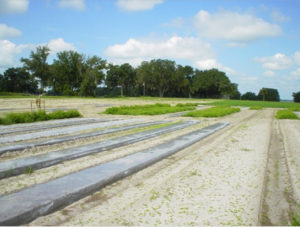Introduction
Tomatoes are the most widely grown vegetable crop in high tunnels throughout Kentucky. This is primarily due to the high value of the crop, particularly since the high tunnels allow for entry into the market several weeks earlier than field planted crops. As a result, many producers do not rotate and continue to grow consecutive tomato crops. The repeated cropping of tomato in the same soil can lead to disease problems such as Fusarium crown rot and white mold (timber rot).
Soil solarization takes advantage of solar radiation to heat the soil to temperatures that are lethal to many fungal pathogens, nematodes, and weed seeds. In Kentucky, soil solarization is not always practical for field use since the period where soil solarization would be useful, summer, is also the period where most growers must produce crops. It could be an option for open fields if a grower had enough land to leave some out of production. This may become increasingly important as fumigation is not a viable option for many growers anymore.
The use of soil solarization in high tunnels, however, may be more practical since these crops are produced earlier than field crops. Additionally, there is chance for greater heating of the soil if the high tunnel vents are all closed, which is another advantage compared to solarizing in an open field. As an example, determinant tomatoes in high tunnels in Kentucky may be grown from the third week of March through July. A second flush of tomatoes may occur in August, but by this time the price of tomatoes may make the continued production of tomatoes into August impractical. Further, at this point in the season, most growers are dealing with significant foliar diseases like leaf mold and insect pests that reduce the growth, size, and yield of tomatoes. In such a case, the high tunnel could instead be used for soil solarization as outlined below.
Soil preparation
All plant material should be removed from the soil to be solarized. The soil should be well-tilled and leveled as if preparing for planting or bed formation. If beds are to be solarized, the beds should be formed and the plastic applied rather than forming the beds after solarization. However, using this method, extra caution must be taken when re-covering with black plastic mulch as you do not want to contaminate solarized with non-solarized soil from the row middles.
Irrigation

Figure 1. Whether clear plastic is used to solarize a raised bed as pictured or a flat field plot, it is essential that the plastic be snug against the well-tilled, irrigated soil. Photo by Shubin K. Saha
Adequately moistened soils will conduct the radiant heat of the sun and are required for the treatment to be effective. It is best to wet the soil to at least 12 inches. Place the plastic on the soil after the soil is irrigated.
Plastic tarp – The best way to trap the radiant energy of the sun is to use clear plastic (Figure 1). In general, the thinner the plastic, the better. One- to 2-mil plastic should work well. Some growers that have effectively solarized high tunnel soils simply utilized the old plastic covering from the existing high tunnel, which is usually 6 mil. However, some growers may want to use a plastic treated with a UV inhibitor so the plastic doesn’t break down too soon. The plastic should be placed snug against the soil.
Temperature
Soil solarization is most likely to be successful if the soil temperature in the top 6 inches reaches 110 to 125 degrees F. Bury at least one soil thermometer so that the temperature of the soil may be monitored without too much disturbance to the tarp. Higher temperatures will be achieved if the high tunnel is closed up, but growers should check to be sure that the high temperatures will not damage any greenhouse equipment or structure. This could include fertilizer injectors, greenhouse controllers, and plastic electrical conduit.
Time
Most soil solarizations for open field will require four to six weeks to be successful. The higher the temperatures achieved, the less time is required. There could be potential to reduce the time to two four weeks given the warmer conditions in high tunnels.
Soil solarization is just one tool to use against soil borne diseases of tomato in high tunnels. It will still be necessary to practice sanitation and keep the area around the high tunnel free of weeds and debris. In some cases, resistant varieties may be used against tomato diseases.
For questions regarding soil solarization, please contact Shubin Saha at (859) 2573374 or shubin.saha@uky.edu, or Dan Egel at (812) 886-0198 or egel@purdue.edu.
Saha, S.K., et al. 2007. Effect of Solarization and Solarization and Cowpea Crop on Plant-Parasitic Nematodes, Pepper Yields, and Weeds. Nematropica 37(1):51-63.
Download this fact sheet here: https://www.uky.edu/Ag/CCD/HortFact7003.pdf




